As we head into the winter break, Chelsea Women are in third place following their shock draw to Liverpool Women last Sunday. However, the Blues have a game in hand and will need to secure three points against Everton later in the season if they want to harbour any hopes of challenging for the title.
The first half of the season has seen Chelsea perform admirably beating Arsenal Women, Manchester City Women and Manchester United Women, taking out three of the best sides in the FAWSL. The result of these wins has come from standout performances from several of their players but none more so than Maren Mjelde. The Norwegian midfielder was forced into playing at right-back early on in the season after a long term injury to Hannah Blundell. Having played at centre-back before moving to right-back, this move represented another shift in role and position but one that Mjelde has accommodated expertly.
This scout report will take a closer look at the attributes Mjelde has shown over the first few months of the season and how she’s made the right-back position her own. We will use tactical analysis to identify her strengths and qualities that have translated from her versatility across several positions.
Defensive Positioning
Chelsea have one of the best defensive records in the FAWSL this season and their defence is one of the main causes of this. A backline including Johanna Andersson, Magdalena Eriksson, Millie Bright, and Mjelde have been tough to break down. The four players have a mixture of strength, pace, and tactical intelligence that make them formidable. The two full-backs are balanced with Mjelde usually sitting deeper than Andersson who prefers to bomb forward. With help from Ingle in shoring up the central areas, they have been able to repel most attacks. Mjelde is a natural defensive midfielder, and her greatest asset is her positioning and defensive ability.
This has been one of the biggest assets in her move to right-back. These skills have set a solid foundation and allowed Mjelde to assert herself against some of the fiercest wingers in the league. The likes of Beth Mead and Leah Galton have terrorised defences this season and Mjelde performed excellently to prevent them both from dominating their flank.
The right-back has averaged 4.13 defensive duels winning over 60% and 7.75 recoveries per 90, with close to 35% of the recoveries coming in the opposition half. She isn’t afraid to take on her winger and wants to play aggressively to ensure she has the upper hand in the duel. This has given her and the team defensive solidarity and forced teams to attack down the opposite flank.
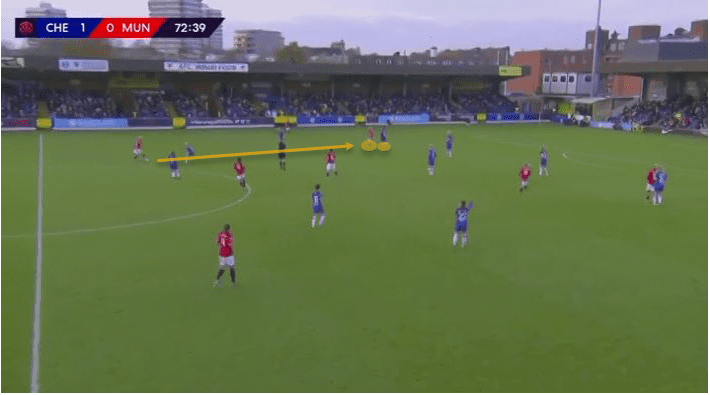
As this example shows, Chelsea’s back four hold an excellent line and Mjelde doesn’t stray far from her marker. In fact, she stays close enough to apply immediate pressure once the pass is received. Mjelde steps into the space in front of her to intercept the pass before Galton has the chance to react. This not only stops Manchester United from getting a chance to regroup and build an attack but puts Chelsea in the ascendency.
Chelsea’s strategy going into games revolves around their pressing tactics. This is an important aspect of their and one that has been vital to their victories against Arsenal, Manchester United and City. Mjelde has been a major part of it playing as the full-back as she pushes up to press certain opposition from higher up the pitch. Her aggressive approach has seen Chelsea able to win back possession from advantageous positions and put them on the front foot. The statistics support her forward forays as she averages 5.07 offensive duels per 90. This aggressiveness allows Chelsea to create numerical superiority with one of the central midfielders and winger dropping in to add pressure.
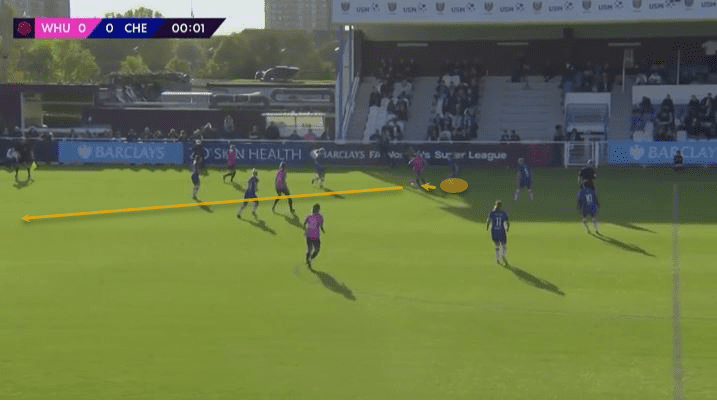
As the example above shows, Mjelde has taken up a much higher position to ensure West Ham Women do not have an easy way out of their own half. Sophie Ingle is the nearest player to help Mjelde in case the defender tries to play her way out or pass forward. The pressure put on the West Ham defender forces her to go all the way back to her goalkeeper.
Movement in the final third
From an attacking perspective, Mjelde has been a real asset and perhaps one of the attributes that have surprised Chelsea the most given her original position as a defensive midfielder. She can often be seen bombing down the flank, combining with her wing partner, making overlapping and underlapping runs, and creating overloads.
The Norwegian defender’s attacking tendencies have been in sync with their talented attackers. Whether it’s Ramona Bachmann or Erin Cuthbert, both players prefer to drift into central positions and play closer to the centre-forward in Bethany England. This frees up space for Mjelde to burst forward and use her newly found attacking ability to great use.

The statistics don’t lie. From what we can see, Mjelde has not only been an attacking force in terms of creating or attacking space but has contributed with goals and assists. In nine matches in the FAWSL, Mjelde has scored two goals and contributed one assist. Her 3.11 dribbles per 90 at a 58.1% success rate is a testament to this.
Especially for a player that was going to provide a balance with the Swedish Andersson on the opposite flank who is expected to provide the attacking impetus. Looking at her statistics, we can see her shot assist at 1.01, 1.52 touches in the box, and 2.03 progressive runs. All of these statistics point towards how effective she’s been in the final third.
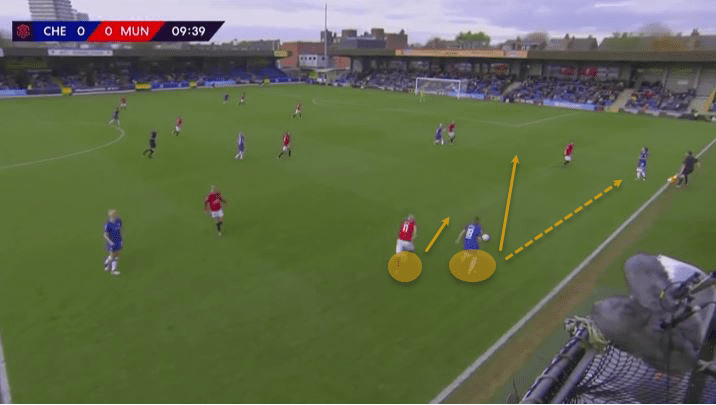
This game against Manchester United from earlier in the season was a prime example of Mjelde’s attacking ability. As the graphic above shows, Mjelde started in a more reserved position but receives possession and manages to dribble past Leah Galton. The right-back drives into the space ahead trying to create a favourable situation for Chelsea.
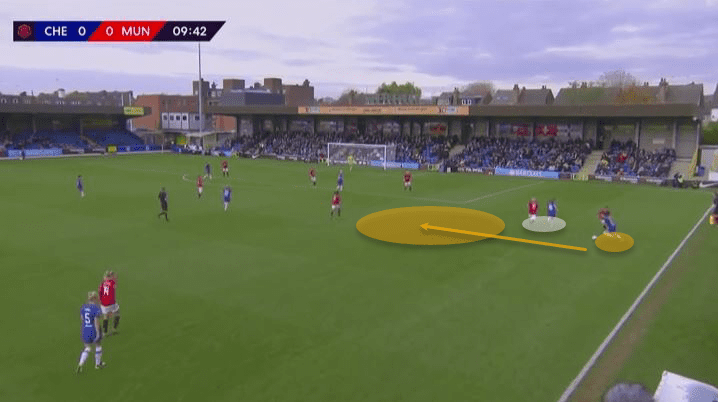
Mjelde continues her run after passing the ball to Bachmann and this automatically creates an opening for the Canadian winger to drive into and create a goal-scoring opportunity. Mjelde’s run takes Galton along with her giving Bachmann a head start over her marker to get a shot or cross away.
Bringing balance to Chelsea
Blundell is slowly but surely making her way back into the fold and this presents a conundrum for Hayes about how she should line up her team. Blundell is a natural option at full-back and would present Chelsea with another tactical option but leaving Mjelde out would not be justified. If we assume Mjelde returns to her natural midfield position, what attributes can she bring to the position?
Chelsea have regularly utilised a 4-4-2 (27%) formation this season with Hayes looking to unleash her wealth of attacking talent together. The manager has also used the 4-2-3-1, showing her capability to adapt to the opposition put in front of her. The introduction of Mjelde into midfield could see her transform from a defensive midfielder to a box-to-box midfielder and play a more dynamic role.
Through analysis, we’ve seen Ji So-yun play a starring role in midfield as the team’s dynamic, creative playmaker from central midfield but also be the main presser in the double pivot with Ingle. On the other hand, the Welsh midfielder has been the more defensive player but does not offer very much in an attacking sense. Mjelde offers a better balance in attack and midfield and could push forward if cover is available. Her attacking forays and understanding of when she should press forward will come in handy in midfield.
Having discussed Mjelde’s attacking abilities earlier, what can the Norwegian bring to midfield going forward? There have been a couple of noticeable improvements and traits that include her crossing and passing ability. Mjelde could take on a Mezzela role that will utilise her newly found attributes. Similar to a box-to-box midfielder but with less defensive responsibility, the Mezzala gets into attacking positions that an inside forward would usually be found in. By moving into these positions she could offer diagonal crosses and through passes for the strikers and pose a different problem to the opposition defence.
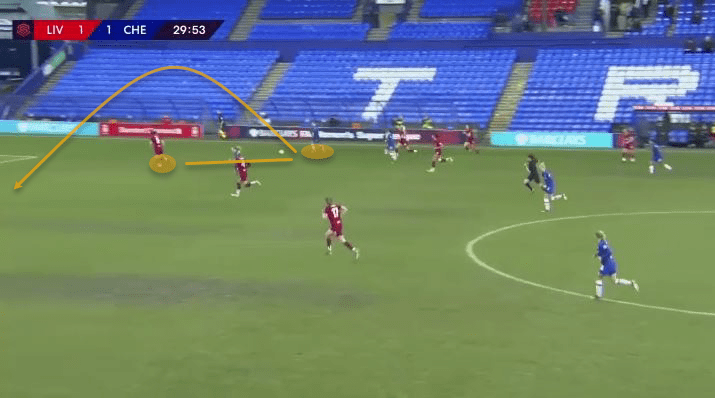
Earlier in this passage of play Bachmann skips past two Liverpool players and releases Mjelde who is in an advanced position. The full-back is now in a one v one position against her counter-part. She has two options to either cross the ball early or dribble past the defender. No pressure is put on Mjelde’s forward and it allowed her to send in an inch-perfect cross for England who narrowly misses the ball but it shows Mjelde’s ability to produce excellent deliveries.
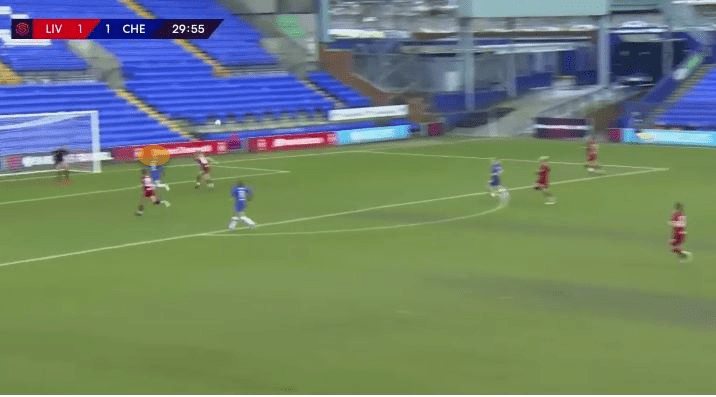
Nordic weapon
Mjelde has been one of Chelsea’s most consistent performers in the first half of the season and has slowly cemented her place in the team. She is one of the first names on the team sheet and without her Chelsea lose a bit of defensive solidarity and dynamism down the right flank. The wingers have benefited from her tactical intelligence and ability to play both on the inside and outside of them, giving the opposition team a torrid time in stopping them. How Hayes conjures up a system and team that includes all her star players is a good headache to have but Mjelde has become the cornerstone to this Chelsea side on the basis of her performances so far.

If you love tactical analysis, then you’ll love the digital magazines from totalfootballanalysis.com – a guaranteed 100+ pages of pure tactical analysis covering topics from the Premier League, Serie A, La Liga, Bundesliga and many, many more. Buy your copy of the December issue for just ₤4.99 here



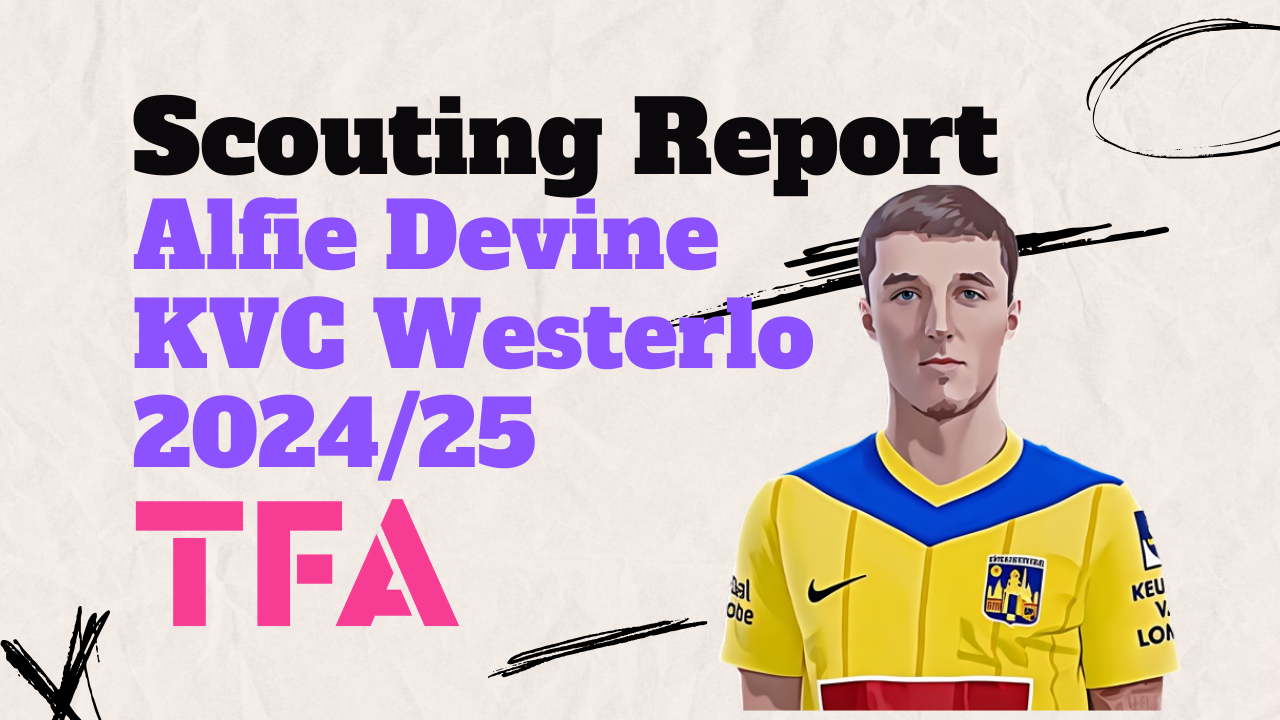
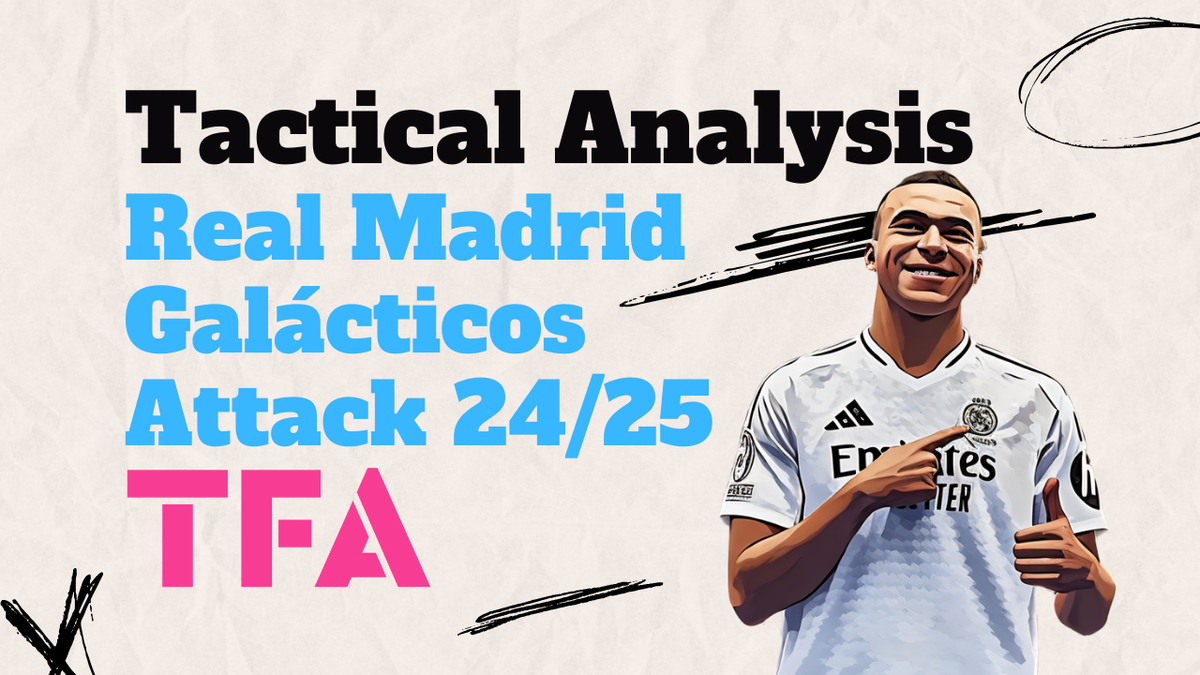
Comments